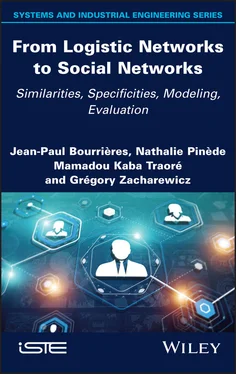5 Chapter 5Figure 5.1. Hourly demand and capacities. For a color version of this figure, se...Figure 5.2. Smart Grid flow chart. For a color version of this figure, see www.i...Figure 5.3. a) Optimized energy mix; b) regulation of the final level of the dam...
6 Chapter 6Figure 6.1. AS IS scenario: demand and inventory status at the start of the week...Figure 6.2. Aggregate transport capacity. For a color version of this figure, se...Figure 6.3. Performance indicators. For a color version of this figure, see www....Figure 6.4. Load rate of transport resources. For a color version of this figure...Figure 6.5. Material supply flows. For a color version of this figure, see www.i...
7 Chapter 7Figure 7.1. BPMN conversation diagram between the pre-interview social network a...Figure 7.2. Diagram showing BPMN collaboration for interview production/broadcas...Figure 7.3. Actor-based agent modeling and simulation. For a color version of th...Figure 7.4. Multi-layer simulation network. For a color version of this figure, ...
1 Cover
2 Table of Contents
3 Title Page Series Editor Jean-Paul Bourrières
4 Copyright First published 2022 in Great Britain and the United States by ISTE Ltd and John Wiley & Sons, Inc. Apart from any fair dealing for the purposes of research or private study, or criticism or review, as permitted under the Copyright, Designs and Patents Act 1988, this publication may only be reproduced, stored or transmitted, in any form or by any means, with the prior permission in writing of the publishers, or in the case of reprographic reproduction in accordance with the terms and licenses issued by the CLA. Enquiries concerning reproduction outside these terms should be sent to the publishers at the undermentioned address: ISTE Ltd 27-37 St George’s Road London SW19 4EU UK www.iste.co.uk John Wiley Sons, Inc 111 River Street Hoboken, NJ 07030 USA www.wiley.com © ISTE Ltd 2022 The rights of Jean-Paul Bourrières, Nathalie Pinède, Mamadou Kaba Traoré and Grégory Zacharewicz to be identified as the authors of this work have been asserted by them in accordance with the Copyright, Designs and Patents Act 1988. Any opinions, findings, and conclusions or recommendations expressed in this material are those of the author(s), contributor(s) or editor(s) and do not necessarily reflect the views of ISTE Group. Library of Congress Control Number: 2022931615 British Library Cataloguing-in-Publication Data A CIP record for this book is available from the British Library ISBN 978-1-78630-657-9
5 Foreword
6 Introduction
7 Begin Reading
8 References
9 Index
10 End User License Agreement
1 v
2 iii
3 iv
4 ix
5 x
6 xi
7 xii
8 xiii
9 xiv
10 xv
11 1
12 3
13 4
14 5
15 6
16 7
17 8
18 9
19 10
20 11
21 12
22 13
23 14
24 15
25 16
26 17
27 18
28 19
29 20
30 21
31 22
32 23
33 25
34 26
35 27
36 28
37 29
38 30
39 31
40 32
41 33
42 34
43 35
44 36
45 37
46 38
47 39
48 40
49 41
50 42
51 43
52 44
53 45
54 46
55 47
56 48
57 49
58 50
59 51
60 52
61 53
62 54
63 55
64 56
65 57
66 58
67 59
68 60
69 61
70 62
71 63
72 64
73 65
74 67
75 69
76 70
77 71
78 72
79 73
80 74
81 75
82 76
83 77
84 78
85 79
86 80
87 81
88 82
89 83
90 84
91 85
92 86
93 87
94 88
95 89
96 91
97 92
98 93
99 94
100 95
101 96
102 97
103 98
104 99
105 100
106 101
107 102
108 103
109 104
110 105
111 106
112 107
113 108
114 109
115 110
116 111
117 112
118 113
119 114
120 115
121 116
122 117
123 119
124 121
125 122
126 123
127 124
128 125
129 126
130 127
131 128
132 129
133 131
134 132
135 133
136 134
137 135
138 136
139 137
140 138
141 139
142 140
143 141
144 143
145 144
146 145
147 146
148 147
149 148
150 149
151 150
152 151
153 152
154 153
155 154
156 155
157 157
158 158
159 159
160 160
161 161
162 162
163 163
164 164
165 165
166 167
167 168
168 169
169 170
170 171
171 172
172 173
173 174
174 175
175 176
176 177
177 178
178 179
179 181
Series Editor
Jean-Paul Bourrières
From Logistic Networks to Social Networks
Similarities, Specificities, Modeling, Evaluation
Jean-Paul Bourrières
Nathalie Pinède
Mamadou Kaba Traoré
Grégory Zacharewicz

First published 2022 in Great Britain and the United States by ISTE Ltd and John Wiley & Sons, Inc.
Apart from any fair dealing for the purposes of research or private study, or criticism or review, as permitted under the Copyright, Designs and Patents Act 1988, this publication may only be reproduced, stored or transmitted, in any form or by any means, with the prior permission in writing of the publishers, or in the case of reprographic reproduction in accordance with the terms and licenses issued by the CLA. Enquiries concerning reproduction outside these terms should be sent to the publishers at the undermentioned address:
ISTE Ltd
27-37 St George’s Road
London SW19 4EU
UK
www.iste.co.uk
John Wiley Sons, Inc
111 River Street
Hoboken, NJ 07030
USA
www.wiley.com
© ISTE Ltd 2022
The rights of Jean-Paul Bourrières, Nathalie Pinède, Mamadou Kaba Traoré and Grégory Zacharewicz to be identified as the authors of this work have been asserted by them in accordance with the Copyright, Designs and Patents Act 1988.
Any opinions, findings, and conclusions or recommendations expressed in this material are those of the author(s), contributor(s) or editor(s) and do not necessarily reflect the views of ISTE Group.
Library of Congress Control Number: 2022931615
British Library Cataloguing-in-Publication Data
A CIP record for this book is available from the British Library
ISBN 978-1-78630-657-9
What original writing on the topic of networks is yet to be written when thousands of books devoted to the subject have been published? This challenge has been taken up by the authors of this book, who have chosen to highlight the many commonalities of the most significant types of networks in order to identify methods and tools for study. This new approach is thus a welcome addition to the literature.
The concept of network has been in common use for several decades. The word itself is quite old. Its etymology goes back to the Latin retiolus, the diminutive of retis, meaning “net”. The English term network is derived from this same “net”. First used in the domains of textile, medicine and military fortifications, as of the 19th century, the word was used to designate all paths, roads and then railways, which run through a particular region or a country. Information and communication technologies have since become the prominent modern-day meaning.
Читать дальше













